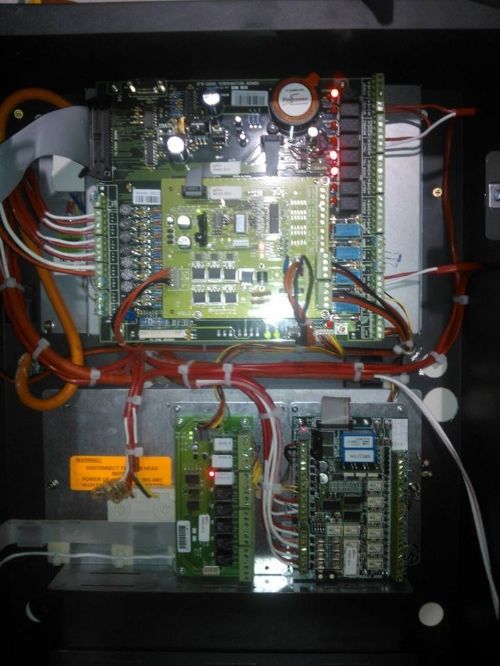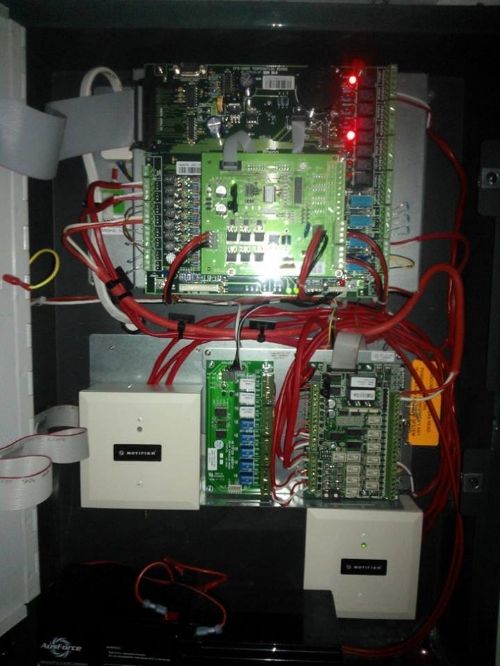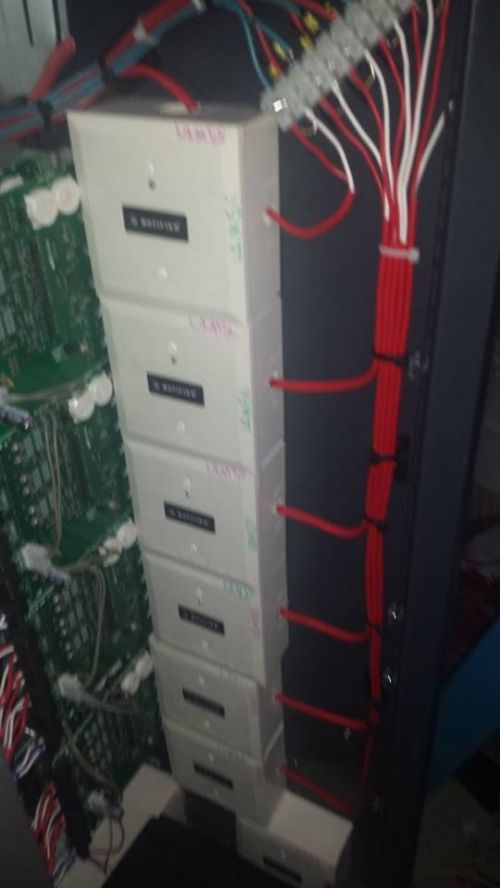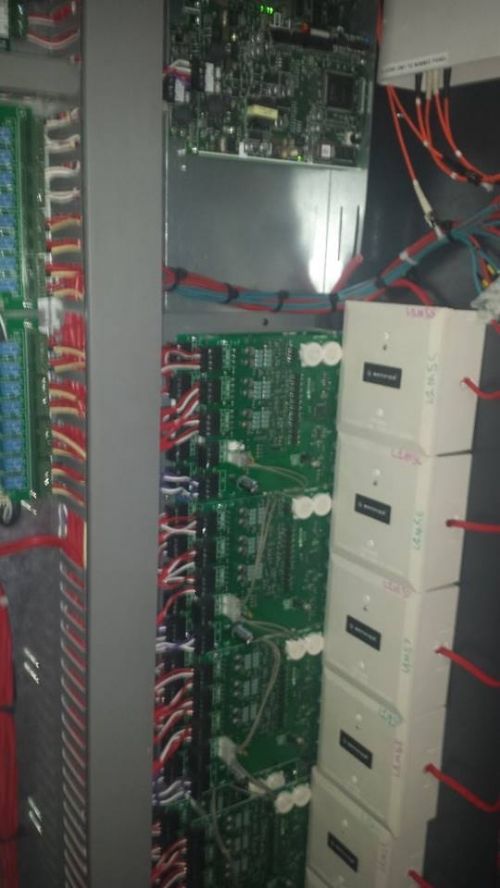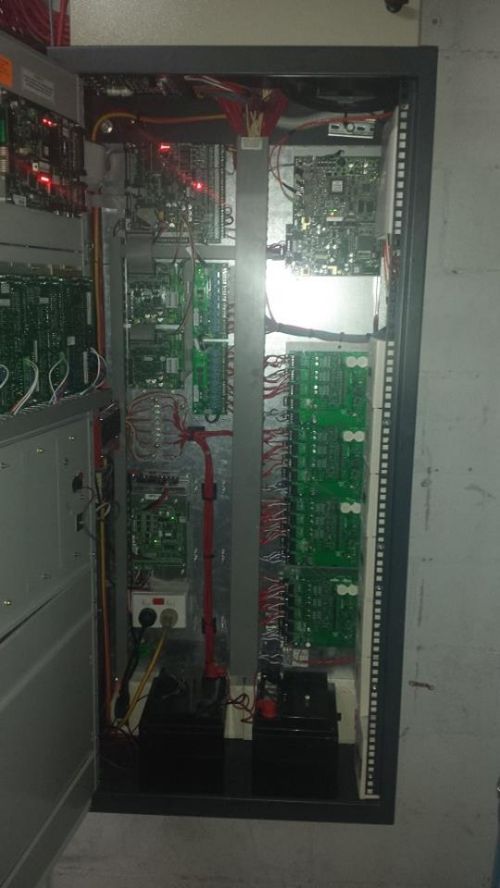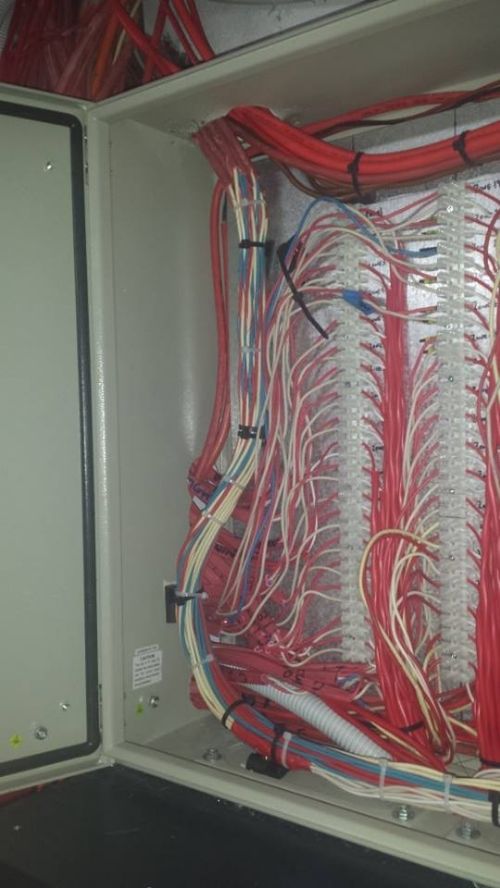im not trying to double post here, but i had to put this in, i was playing about with speccy and managed to do this
Generated by Piriform Speccy v1.24.632
07 Dec 2013 @ 22:09
Summary
Operating System
Windows 8 Pro 64-bit
CPU
Intel Core i5 2320 @ 3.00GHz: 31 °C
Sandy Bridge 32nm Technology
RAM
12.0GB Dual-Channel DDR3 @ 796MHz (9-9-9-24)
Motherboard
ASUSTeK COMPUTER INC. P8Z77-V LX (LGA1155): 30 °C
Graphics
HP x2301 (1920x1080@60Hz)
22LG3000 (1680x1050@59Hz)
S236HL (1920x1080@60Hz)
3071MB NVIDIA GeForce GTX 660 (EVGA): 40 °C
2047MB NVIDIA GeForce GT 520 (EVGA): 37 °C
ForceWare version: 331.58
SLI Disabled
Storage
55GB OCZ-AGILITY3 ATA Device (SSD): 30 °C
931GB Seagate ST1000DL002-9TT153 ATA Device (SATA): 30 °C
Optical Drives
No optical disk drives detected
Audio
NVIDIA High Definition Audio
Operating System
Windows 8 Pro 64-bit
Computer type: Virtual
Installation Date: 28/08/2013 19:34:07
Uptime
Current Session
Current Time: 07/12/2013 22:09:29
Current Uptime: 619,598 sec (7 d, 04 h, 06 m, 38 s)
Last Boot Time: 30/11/2013 18:02:51
Running: Razer Overlay Subsystem Emergency Service
Running: Razer Surround Audio Service
TimeZone
TimeZone: GMT
Language: English (United Kingdom)
Location: United Kingdom
Format: English (United Kingdom)
Currency: £
Date Format: dd/MM/yyyy
Time Format: HH:mm:ss
Device Tree
ACPI x64-based PC
Microsoft ACPI-Compliant System
ACPI Fan
ACPI Fan
ACPI Fan
ACPI Fan
ACPI Fan
ACPI Fixed Feature Button
ACPI Power Button
ACPI Thermal Zone
ACPI Thermal Zone
Intel Core i5-2320 CPU @ 3.00GHz
Intel Core i5-2320 CPU @ 3.00GHz
Intel Core i5-2320 CPU @ 3.00GHz
Intel Core i5-2320 CPU @ 3.00GHz
Microsoft Windows Management Interface for ACPI
PCI Express Root Complex
2nd Generation Intel Core Processor Family DRAM Controller - 0100
Intel 7 Series/C216 Chipset Family SMBus Host Controller - 1E22
Intel Management Engine Interface
Motherboard resources
System board
Xeon E3-1200/2nd Generation Intel(R) Core(TM) Processor Family PCI Express Root Port - 0101
NVIDIA GeForce GTX 660
Generic PnP Monitor
Generic PnP Monitor
High Definition Audio Controller
NVIDIA High Definition Audio
22LG3000-2 (2- NVIDIA High Definition Audio)
Intel(R) USB 3.0 eXtensible Host Controller - 0100 (Microsoft)
USB Root Hub (xHCI)
Xbox 360 Wireless Receiver for Windows
USB Composite Device
Tartarus Input Device
Razer Tartarus
Razer Tartarus
HID-compliant game controller
USB Input Device
HID Keyboard Device
HID-compliant consumer control device
HID-compliant device
HID-compliant device
HID-compliant device
USB Input Device
Razer Tartarus
Standard Enhanced PCI to USB Host Controller
USB Root Hub
Generic USB Hub
High Definition Audio Controller
High Definition Audio Device
Digital Audio (S/PDIF) (2- High Definition Audio Device)
Digital Audio (S/PDIF) (2- High Definition Audio Device)
Headphones (2- High Definition Audio Device)
Microphone (2- High Definition Audio Device)
Speakers (2- High Definition Audio Device)
Intel(R) 7 Series/C216 Chipset Family PCI Express Root Port 1 - 1E10
NVIDIA GeForce GT 520
Generic PnP Monitor
High Definition Audio Controller
NVIDIA High Definition Audio
S236HL-1 (NVIDIA High Definition Audio)
Intel(R) 7 Series/C216 Chipset Family PCI Express Root Port 5 - 1E18
Realtek PCIe GBE Family Controller
Intel(R) 82801 PCI Bridge - 244E
PCI standard PCI-to-PCI bridge
Intel(R) 7 Series/C216 Chipset Family PCI Express Root Port 7 - 1E1C
TP-LINK Wireless PCI Express Adapter
Microsoft Wi-Fi Direct Virtual Adapter
Standard Enhanced PCI to USB Host Controller
USB Root Hub
Generic USB Hub
Logitech USB Camera (HD Pro Webcam C920)
Logitech HD Pro Webcam C920
HD Pro Webcam C920
Microphone (HD Pro Webcam C920)
USB Input Device
HID-compliant mouse
USB Composite Device
USB Input Device
HID Keyboard Device
Razer BlackWidow Ultimate
HID-compliant consumer control device
HID-compliant device
HID-compliant device
HID-compliant device
Razer BlackWidow Ultimate
USB Input Device
Razer BlackWidow Ultimate
Intel(R) Z77 Express Chipset LPC Controller - 1E44
Communications Port (COM1)
Direct memory access controller
High precision event timer
Intel 82802 Firmware Hub Device
Motherboard resources
Motherboard resources
Motherboard resources
Motherboard resources
Numeric data processor
Programmable interrupt controller
System CMOS/real time clock
System timer
Standard Dual Channel PCI IDE Controller
ATA Channel 0
OCZ-AGILITY3 ATA Device
ATA Channel 1
ST1000DL002-9TT153 ATA Device
Standard Dual Channel PCI IDE Controller
ATA Channel 0
ATA Channel 1
CPU
Intel Core i5 2320
Cores: 4
Threads: 4
Name: Intel Core i5 2320
Code Name: Sandy Bridge
Package: Socket 1155 LGA
Technology: 32nm
Specification: Intel Core i5-2320 CPU @ 3.00GHz
Family: 6
Extended Family: 6
Model: A
Extended Model: 2A
Stepping: 7
Revision: D2
Instructions: MMX, SSE, SSE2, SSE3, SSSE3, SSE4.1, SSE4.2, Intel 64, NX, AES, AVX
Virtualization: Not supported
Hyperthreading: Supported, Disabled
Fan Speed: 713 RPM
Bus Speed: 99.8 MHz
Stock Core Speed: 3000 MHz
Stock Bus Speed: 100 MHz
Average Temperature: 31 °C
Caches
L1 Data Cache Size: 4 x 32 KBytes
L1 Instructions Cache Size: 4 x 32 KBytes
L2 Unified Cache Size: 4 x 256 KBytes
L3 Unified Cache Size: 6144 KBytes
Core 0
Core Speed: 2993.2 MHz
Multiplier: x 30.0
Bus Speed: 99.8 MHz
Temperature: 33 °C
Thread 1
APIC ID: 0
Core 1
Core Speed: 2993.2 MHz
Multiplier: x 30.0
Bus Speed: 99.8 MHz
Temperature: 32 °C
Thread 1
APIC ID: 2
Core 2
Core Speed: 2993.2 MHz
Multiplier: x 30.0
Bus Speed: 99.8 MHz
Temperature: 31 °C
Thread 1
APIC ID: 4
Core 3
Core Speed: 2993.2 MHz
Multiplier: x 30.0
Bus Speed: 99.8 MHz
Temperature: 27 °C
Thread 1
APIC ID: 6
RAM
Memory slots
Total memory slots: 4
Used memory slots: 4
Free memory slots: 0
Memory
Type: DDR3
Size: 12288 MBytes
Channels #: Dual
DRAM Frequency: 798.2 MHz
CAS# Latency (CL): 9 clocks
RAS# to CAS# Delay (tRCD): 9 clocks
RAS# Precharge (tRP): 9 clocks
Cycle Time (tRAS): 24 clocks
Command Rate (CR): 2T
Physical Memory
Memory Usage: 36 %
Total Physical: 12 GB
Available Physical: 7.65 GB
Total Virtual: 14 GB
Available Virtual: 7.63 GB
SPD
Number Of SPD Modules: 4
Slot #1
Type: DDR3
Size: 2048 MBytes
Manufacturer: Corsair
Max Bandwidth: PC3-10700H (667 MHz)
Part Number: CMX4GX3M2B1600C9
SPD Ext.: XMP
XMP-1600
Frequency: 800 MHz
CAS# Latency: 9.0
RAS# To CAS#: 9
RAS# Precharge: 9
tRAS: 24
Voltage: 1.500 V
JEDEC #3
Frequency: 666.7 MHz
CAS# Latency: 9.0
RAS# To CAS#: 9
RAS# Precharge: 9
tRAS: 24
tRC: 34
Voltage: 1.500 V
JEDEC #2
Frequency: 592.6 MHz
CAS# Latency: 8.0
RAS# To CAS#: 8
RAS# Precharge: 8
tRAS: 22
tRC: 30
Voltage: 1.500 V
JEDEC #1
Frequency: 444.4 MHz
CAS# Latency: 6.0
RAS# To CAS#: 6
RAS# Precharge: 6
tRAS: 16
tRC: 23
Voltage: 1.500 V
Slot #2
Type: DDR3
Size: 4096 MBytes
Manufacturer: Corsair
Max Bandwidth: PC3-10700H (667 MHz)
Part Number: CMZ8GX3M2A1600C9
SPD Ext.: XMP
XMP-1600
Frequency: 800 MHz
CAS# Latency: 9.0
RAS# To CAS#: 9
RAS# Precharge: 9
tRAS: 24
Voltage: 1.500 V
JEDEC #4
Frequency: 666.7 MHz
CAS# Latency: 9.0
RAS# To CAS#: 9
RAS# Precharge: 9
tRAS: 24
tRC: 34
Voltage: 1.500 V
JEDEC #3
Frequency: 592.6 MHz
CAS# Latency: 8.0
RAS# To CAS#: 8
RAS# Precharge: 8
tRAS: 22
tRC: 30
Voltage: 1.500 V
JEDEC #2
Frequency: 518.5 MHz
CAS# Latency: 7.0
RAS# To CAS#: 7
RAS# Precharge: 7
tRAS: 19
tRC: 27
Voltage: 1.500 V
JEDEC #1
Frequency: 444.4 MHz
CAS# Latency: 6.0
RAS# To CAS#: 6
RAS# Precharge: 6
tRAS: 16
tRC: 23
Voltage: 1.500 V
Slot #3
Type: DDR3
Size: 2048 MBytes
Manufacturer: Corsair
Max Bandwidth: PC3-10700H (667 MHz)
Part Number: CMX4GX3M2B1600C9
SPD Ext.: XMP
XMP-1600
Frequency: 800 MHz
CAS# Latency: 9.0
RAS# To CAS#: 9
RAS# Precharge: 9
tRAS: 24
Voltage: 1.500 V
JEDEC #3
Frequency: 666.7 MHz
CAS# Latency: 9.0
RAS# To CAS#: 9
RAS# Precharge: 9
tRAS: 24
tRC: 34
Voltage: 1.500 V
JEDEC #2
Frequency: 592.6 MHz
CAS# Latency: 8.0
RAS# To CAS#: 8
RAS# Precharge: 8
tRAS: 22
tRC: 30
Voltage: 1.500 V
JEDEC #1
Frequency: 444.4 MHz
CAS# Latency: 6.0
RAS# To CAS#: 6
RAS# Precharge: 6
tRAS: 16
tRC: 23
Voltage: 1.500 V
Slot #4
Type: DDR3
Size: 4096 MBytes
Manufacturer: Corsair
Max Bandwidth: PC3-10700H (667 MHz)
Part Number: CMZ8GX3M2A1600C9
SPD Ext.: XMP
XMP-1600
Frequency: 800 MHz
CAS# Latency: 9.0
RAS# To CAS#: 9
RAS# Precharge: 9
tRAS: 24
Voltage: 1.500 V
JEDEC #4
Frequency: 666.7 MHz
CAS# Latency: 9.0
RAS# To CAS#: 9
RAS# Precharge: 9
tRAS: 24
tRC: 34
Voltage: 1.500 V
JEDEC #3
Frequency: 592.6 MHz
CAS# Latency: 8.0
RAS# To CAS#: 8
RAS# Precharge: 8
tRAS: 22
tRC: 30
Voltage: 1.500 V
JEDEC #2
Frequency: 518.5 MHz
CAS# Latency: 7.0
RAS# To CAS#: 7
RAS# Precharge: 7
tRAS: 19
tRC: 27
Voltage: 1.500 V
JEDEC #1
Frequency: 444.4 MHz
CAS# Latency: 6.0
RAS# To CAS#: 6
RAS# Precharge: 6
tRAS: 16
tRC: 23
Voltage: 1.500 V
Motherboard
Manufacturer: ASUSTeK COMPUTER INC.
Model: P8Z77-V LX (LGA1155)
Chipset Vendor: Intel
Chipset Model: Sandy Bridge
Chipset Revision: 09
Southbridge Vendor: Intel
Southbridge Model: Z77
Southbridge Revision: 04
System Temperature: 30 °C
BIOS
Brand: American Megatrends Inc.
Version: 0401
Date: 14/02/2012
Voltage
CPU CORE: 1.016 V
MEMORY CONTROLLER: 1.016 V
AVCC: 3.312 V
3VCC: 3.312 V
VIN4: 1.008 V
VIN6: 0.920 V
VIN7: 0.152 V
VIN8: 1.016 V
VIN9: 0.120 V
VIN10: 1.008 V
VIN11: 1.016 V
PCI Data
Slot PCI-E
Slot Type: PCI-E
Slot Usage: In Use
Bus Width: 32 bit
Slot Designation: PCIEX16_1
Characteristics: 3.3V, Shared, PME
Slot Number: 0
Slot PCI-E
Slot Type: PCI-E
Slot Usage: In Use
Bus Width: 32 bit
Slot Designation: PCIEX1_1
Characteristics: 3.3V, Shared, PME
Slot Number: 1
Slot PCI-E
Slot Type: PCI-E
Slot Usage: Available
Bus Width: 32 bit
Slot Designation: PCIEX1_2
Characteristics: 3.3V, Shared, PME
Slot Number: 2
Slot PCI
Slot Type: PCI
Slot Usage: Available
Bus Width: 32 bit
Slot Designation: PCI1
Characteristics: 3.3V, Shared, PME
Slot Number: 3
Slot PCI
Slot Type: PCI
Slot Usage: Available
Bus Width: 32 bit
Slot Designation: PCI2
Characteristics: 3.3V, Shared, PME
Slot Number: 4
Slot PCI
Slot Type: PCI
Slot Usage: Available
Bus Width: 32 bit
Slot Designation: PCI3
Characteristics: 3.3V, Shared, PME
Slot Number: 5
Slot PCI-E
Slot Type: PCI-E
Slot Usage: In Use
Bus Width: 32 bit
Slot Designation: PCIEX16_2
Characteristics: 3.3V, Shared, PME
Slot Number: 6
Graphics
Monitor 1
Name: HP x2301 on NVIDIA GeForce GTX 660
Current Resolution: 1920x1080 pixels
Work Resolution: 1920x1040 pixels
State: Enabled, Output devices support
Multiple displays: Extended, Primary, Enabled
Monitor Width: 1920
Monitor Height: 1080
Monitor BPP: 32 bits per pixel
Monitor Frequency: 60 Hz
Device: \\.\DISPLAY1\Monitor0
Monitor 2
Name: 22LG3000 on NVIDIA GeForce GTX 660
Current Resolution: 1680x1050 pixels
Work Resolution: 1680x1050 pixels
State: Enabled, Output devices support
Multiple displays: Extended, Secondary, Enabled
Monitor Width: 1680
Monitor Height: 1050
Monitor BPP: 32 bits per pixel
Monitor Frequency: 59 Hz
Device: \\.\DISPLAY2\Monitor0
Monitor 3
Name: S236HL on NVIDIA GeForce GT 520
Current Resolution: 1920x1080 pixels
Work Resolution: 1920x1080 pixels
State: Enabled, Output devices support
Multiple displays: Extended, Secondary, Enabled
Monitor Width: 1920
Monitor Height: 1080
Monitor BPP: 32 bits per pixel
Monitor Frequency: 60 Hz
Device: \\.\DISPLAY5\Monitor0
NVIDIA GeForce GTX 660
Manufacturer: NVIDIA
Model: GeForce GTX 660
Device ID: 10DE-11C0
Revision: A2
Subvendor: EVGA (3842)
Current Performance Level: Level 1
Current GPU Clock: 324 MHz
Current Memory Clock: 324 MHz
Voltage: 0.862 V
Bus Interface: PCI Express x16
Temperature: 40 °C
SLI: Disabled
Driver version: 9.18.13.3158
BIOS Version: 80.06.10.00.61
Physical Memory: 3071 MB
Virtual Memory: 3072 MB
Count of performance levels : 4
Level 1 - "2D Desktop"
GPU Clock: 324 MHz
Memory Clock: 324 MHz
Level 2 - "Default"
GPU Clock: 324 MHz
Memory Clock: 810 MHz
Level 3 - "Unknown"
GPU Clock: 549 MHz
Memory Clock: 3004 MHz
Level 4 - "Unknown"
GPU Clock: 549 MHz
Memory Clock: 3004 MHz
NVIDIA GeForce GT 520
Manufacturer: NVIDIA
Model: GeForce GT 520
GPU: GF119
Device ID: 10DE-1040
Revision: A2
Subvendor: EVGA (3842)
Current Performance Level: Level 1
Current GPU Clock: 270 MHz
Current Memory Clock: 324 MHz
Current Shader Clock: 540 MHz
Voltage: 0.862 V
Die Size: 79 mm²
Release Date: Apr 12, 2011
DirectX Support: 11.0
OpenGL Support: 5.0
Bus Interface: PCI Express x4
Temperature: 37 °C
SLI: Disabled
Driver version: 9.18.13.3158
BIOS Version: 75.19.1b.00.24
ROPs: 4
Shaders: 48 unified
Memory Type: DDR3
Physical Memory: 2047 MB
Virtual Memory: 2048 MB
Bus Width: 32x2 (64 bit)
Filtering Modes: 16x Anisotropic
Noise Level: Silent
Max Power Draw: 29 Watts
Count of performance levels : 2
Level 1 - "2D Desktop"
GPU Clock: 270 MHz
Memory Clock: 324 MHz
Shader Clock: 540 MHz
Level 2 - "Unknown"
GPU Clock: 821 MHz
Memory Clock: 500 MHz
Shader Clock: 1642 MHz
Storage
Hard drives
OCZ-AGILITY3 ATA Device
Manufacturer: OCZ
Heads: 16
Cylinders: 7,297
Tracks: 1,860,735
Sectors: 117,226,305
SATA type: SATA-III 6.0Gb/s
Device type: Fixed
ATA Standard: ATA8-ACS
Serial Number: OCZ-76K4N989NNW5243H
LBA Size: 48-bit LBA
Power On Count: 266 times
Power On Time: 51.3 days
Speed: Not used (SSD Drive)
Features: S.M.A.R.T., APM, NCQ, TRIM, SSD
Transfer Mode: SATA III
Interface: SATA
Capacity: 55 GB
Real size: 60,022,480,896 bytes
RAID Type: None
S.M.A.R.T
Status: Good
Temperature: 30 °C
Temperature Range: OK (less than 50 °C)
01 Read Error Rate: 120 (120) Data 0000000000
05 Retired Block Count: 100 (100) Data 0000000000
09 Power-On Hours (POH): 000 (000) Data 00000004CF
0C Device Power Cycle Count: 100 (100) Data 000000010A
AB Program Fail Block Count: 000 (000) Data 0000000000
AC Erase Fail Block Count: 000 (000) Data 0000000000
AE Unexpected Power Loss: 000 (000) Data 000000001E
B1 Wear Range Delta: 000 (000) Data 0000000002
B5 Program Fail Count: 000 (000) Data 0000000000
B6 Erase Fail Count: 000 (000) Data 0000000000
BB Reported Uncorrectable Errors: 100 (100) Data 0000000000
C2 Temperature: 030 (030) Data 00001E001E
C3 On the fly ECC Uncorrectable Error Count: 100 (100) Data 0000000000
C4 Reallocation Event Count: 100 (100) Data 0000000000
C9 Uncorrectable Soft Read Error Rate: 100 (100) Data 0000000000
CC Soft ECC Correction Rate: 100 (100) Data 0000000000
E6 Life Curve Status: 100 (100) Data 0000000064
E7 SSD Life Left: 100 (100) Data 0000000000
E9 Vendor Specific: 000 (000) Data 00000004F0
EA Vendor Specific: 000 (000) Data 000000059B
F1 Lifetime Writes from Host: 000 (000) Data 000000059B
F2 Lifetime Reads from Host: 000 (000) Data 00000002AB
Partition 0
Partition ID: Disk #0, Partition #0
Size: 300 MB
Partition 1
Partition ID: Disk #0, Partition #1
Size: 100 MB
Partition 2
Partition ID: Disk #0, Partition #2
Disk Letter: C:
File System: NTFS
Size: 55 GB
Used Space: 54 GB (99%)
Free Space: 613 MB (1%)
ST1000DL002-9TT153 ATA Device
Manufacturer: Seagate
Heads: 16
Cylinders: 121,601
Tracks: 31,008,255
Sectors: 1,953,520,065
SATA type: SATA-III 6.0Gb/s
Device type: Fixed
ATA Standard: ATA8-ACS
Serial Number: W1V12RDP
LBA Size: 48-bit LBA
Power On Count: 516 times
Power On Time: 171.3 days
Speed: 5900 RPM
Features: S.M.A.R.T., AAM, NCQ
Transfer Mode: SATA III
Interface: SATA
Capacity: 931 GB
Real size: 1,000,204,886,016 bytes
RAID Type: None
S.M.A.R.T
Status: Good
Temperature: 30 °C
Temperature Range: OK (less than 50 °C)
01 Read Error Rate: 117 (099) Data 00099908C0
03 Spin-Up Time: 093 (092) Data 0000000000
04 Start/Stop Count: 100 (100) Data 00000002F9
05 Reallocated Sectors Count: 100 (100) Data 0000000000
07 Seek Error Rate: 072 (060) Data 00091949C3
09 Power-On Hours (POH): 096 (096) Data 0000001010
0A Spin Retry Count: 100 (100) Data 0000000000
0C Device Power Cycle Count: 100 (100) Data 0000000204
B7 SATA Downshift Error Count: 100 (100) Data 0000000000
B8 End-to-End error / IOEDC: 100 (100) Data 0000000000
BB Reported Uncorrectable Errors: 100 (100) Data 0000000000
BC Command Timeout: 100 (099) Data 0000010007
BD High Fly Writes (WDC): 100 (100) Data 0000000000
BE Temperature Difference from 100: 071 (056) Data 001D16001D
BF G-sense error rate: 100 (100) Data 0000000000
C0 Power-off Retract Count: 100 (100) Data 0000000045
C1 Load/Unload Cycle Count: 100 (100) Data 0000000308
C2 Temperature: 029 (044) Data 000000001D
C3 Hardware ECC Recovered: 021 (013) Data 00099908C0
C5 Current Pending Sector Count: 100 (100) Data 0000000000
C6 Uncorrectable Sector Count: 100 (100) Data 0000000000
C7 UltraDMA CRC Error Count: 200 (200) Data 0000000D9C
F0 Head Flying Hours: 100 (253) Data 0000000DBE
F1 Total LBAs Written: 100 (253) Data 009BB59084
F2 Total LBAs Read: 100 (253) Data 006B589027
Partition 0
Partition ID: Disk #1, Partition #0
Disk Letter: D:
File System: NTFS
Size: 99 MB
Used Space: 40 MB (41%)
Free Space: 59 MB (59%)
Partition 1
Partition ID: Disk #1, Partition #1
Disk Letter: E:
File System: NTFS
Volume Serial Number: 4A28BA97
Size: 931 GB
Used Space: 839 GB (91%)
Free Space: 91 GB (9%)
Optical Drives
No optical disk drives detected
Audio
Sound Cards
NVIDIA High Definition Audio
High Definition Audio Device
HD Pro Webcam C920
NVIDIA High Definition Audio
NVIDIA Virtual Audio Device (Wave Extensible) (WDM)
Razer Surround Audio Controller
Playback Devices
Speakers (2- High Definition Audio Device)
Headphones (2- High Definition Audio Device)
22LG3000-2 (2- NVIDIA High Definition Audio): (default)
Digital Audio (S/PDIF) (2- High Definition Audio Device)
S236HL-1 (NVIDIA High Definition Audio)
Digital Audio (S/PDIF) (2- High Definition Audio Device)
Recording Devices
Microphone (HD Pro Webcam C920): (default)
Microphone (2- High Definition Audio Device)
Peripherals
HID Keyboard Device
Device Kind: Keyboard
Device Name: HID Keyboard Device
Vendor: ECHELON
Location: USB Input Device
Driver
Date: 6-21-2006
Version: 6.2.9200.16548
 . Trust me, I do the occasional build where I get paid but usually its for mates and for free (obviously they buy the parts). It's fun, gives you a nice portfolio and keeps you in practice. ^_^ It also gives you experience in building different rigs for different specifications that you wouldn't normally do such as SFF builds.
. Trust me, I do the occasional build where I get paid but usually its for mates and for free (obviously they buy the parts). It's fun, gives you a nice portfolio and keeps you in practice. ^_^ It also gives you experience in building different rigs for different specifications that you wouldn't normally do such as SFF builds.
